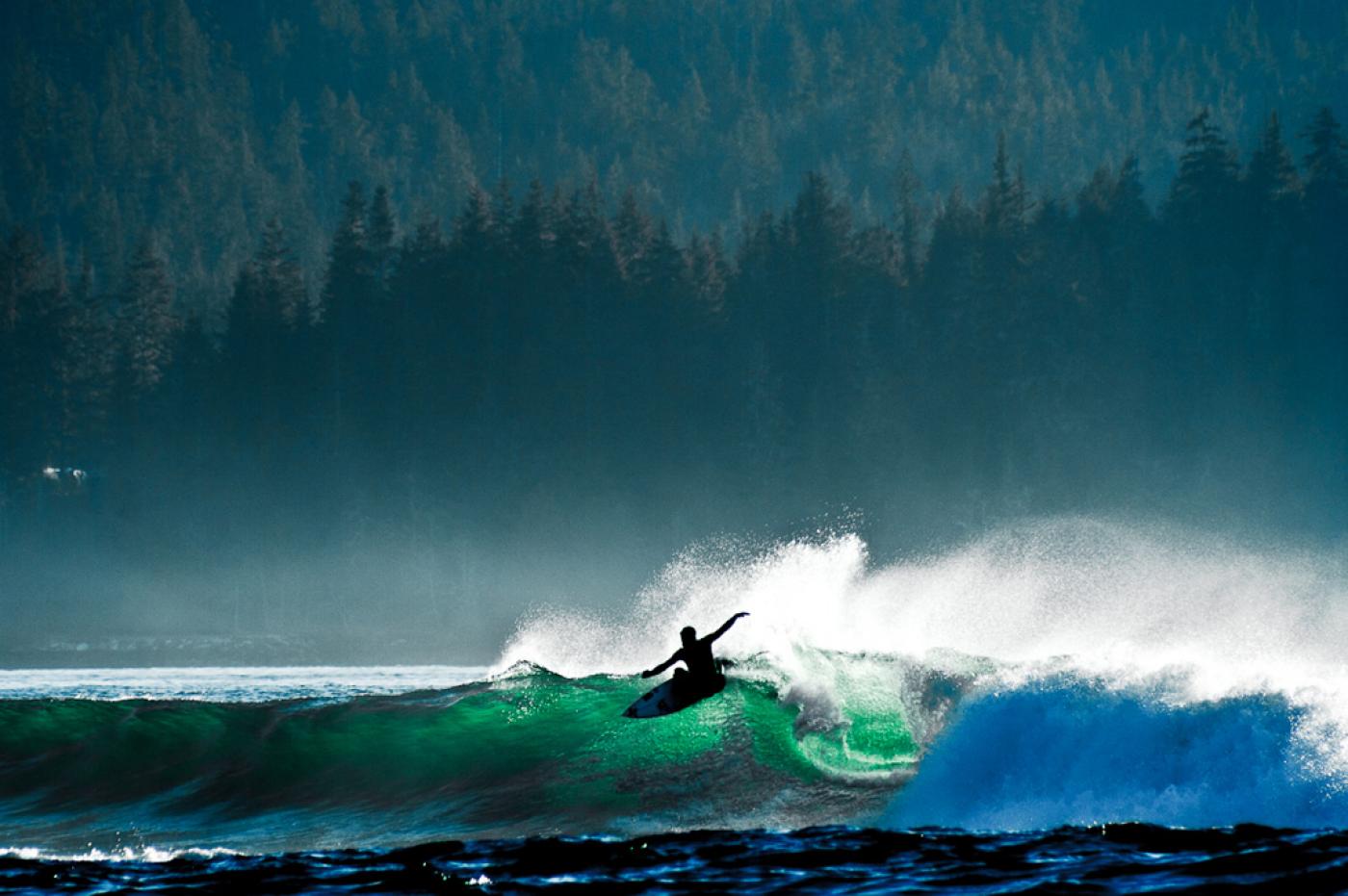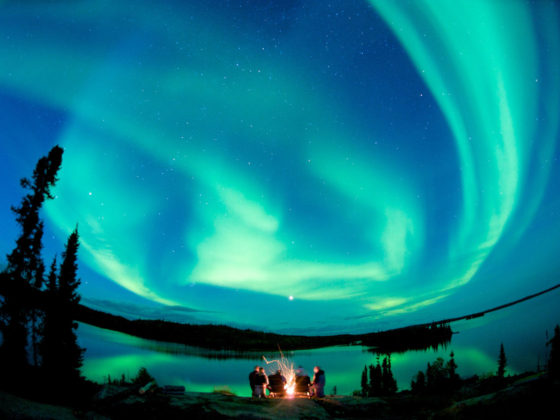PARTYING AT THE LARGEST comedy festival on Earth and kayaking in the world’s highest tides, drinking Iceberg Vodka — while looking out at icebergs — and exploring North America’s only walled city north of Mexico. You can’t do any of these things in the US, but you can do all of them in Canada.
This is a wildly diverse country, where unique experiences are yours for the taking. There’s a dream trip for everyone up here — is yours one of the 12 listed below?
1. Kayak in the world’s highest tides in New Brunswick.

Photo: Tourism New Brunswick
Yep, New Brunswick’s Bay of Fundy is home to the highest tides on the planet, with as much as a 53-foot swing between high and low tides — that’s taller than a four-story building. A direct result of the phenomenon is the extreme tidal erosion that’s shaped the coast in this part of Eastern Canada, and the Bay of Fundy in particular.
Meet the pillared formations known as the Hopewell Rocks. They stand 40-70 feet tall, and the red of their sandstone is a sharp contrast to the blues and greens of the surrounding ocean and trees. Honestly, it’s impossible to take a bad picture here.
At low tide, you can walk the beach searching for seashells and exploring the tiny coves found around the cliff faces. High tide comes twice a day, quickly swallowing up the shore and turning the Hopewell Rocks into small islands. Once the tide is in, it’s time to head out on a kayaking excursion with Baymount Outdoor Adventures.
There’s also an extensive network of hiking trails in the Hopewell Rocks area. Take the trail to Demoiselle Beach, a sandy cove framed by salt marshes and more towering rock formations.
2. Explore North America’s only walled city north of Mexico.
Wander the cobblestone streets of Old Québec and you won’t just see street performers entertaining crowds at the sidewalk cafés; North America’s oldest shopping street; and bistros, boutiques, galleries, and 400-year-old buildings like the Augustinian Monastery. You’ll also get to check out the 17th-century French- and British-built defensive structures that make Québec City the only fortified city on the continent north of Mexico.
For an epic sunset, head to the Dufferin Terrace boardwalk. It’s right next to the skyline-defining Château Frontenac Hotel at the tippy top of Cap Diamant, where you’ll get to see the whole city, the St. Lawrence River, and all the way to the Laurentian Mountains in the distance.
3. See the sky do extraordinary things in the Territories.

Photo: Destination Canada
Head up north to Dawson City, Yukon, and you can play a round of golf in the middle of the night, thanks to a sun that never sets during the height of summer. There’s even a Midnight Sun Golf Tournament, with participants teeing off at midnight. Play throughout the “night” and finish in the morning with a big breakfast of beer and eggs.
If golf isn’t your thing, get up to Yellowknife in the Northwest Territories for some Northern Lights viewing starting around late August. Nights are long and clear, and since the territories are so flat, you’ll have endless views of the aurora borealis from just about anywhere.
4. Visit the world’s largest jazz festival and the world’s largest comedy festival in Montréal.

Photo: Charles William Pelletier, © Just for Laughs Festival
There are a million and one reasons to love Montréal, especially in the summer months when the city really comes alive with festivals. It makes sense that the world’s largest jazz festival and the world’s largest comedy festival would both take place here.
In June and July, you get 10 days of live jazz performances, followed by two weeks of laughter. The Montréal International Jazz Festival isn’t just a celebration of jazz, though — blues, Latin, reggae, electronica, and plenty of other styles are showcased during this massive event. There are literally hundreds of free shows taking place in the downtown area, and plenty of big names come through as well. Aretha Franklin and B.B. King have performed here in the past.
Equally diverse is the Just for Laughs comedy festival. Spend some time at Place des Festivals and you’ll see live comedy, circus acts, acrobats, and street dancing. There’s even a twins (and triplets, and quadruplets…) parade. Events take place all over town, and you can pick up an official “passport” for discount prices. If you show up without planning ahead, go to Place des Festivals to see if there are last-minute tickets.
5. Be the first to see films that will become Academy Award contenders in Toronto.

Photo: Destination Canada
The Toronto International Film Festival has a knack for premiering flicks that go on to become Oscar-nominated (or Oscar-winning) films, like The Martian, Dallas Buyers Club, Still Alice, Argo, and Silver Linings Playbook — to name just a few. The festival happens every year in September, and welcomes nearly 500,000 visitors, big-name celebrities among them; George Clooney and Brad Pitt have been known to show up.
Of course, if movies and A-listers aren’t your thing, you can still find a Toronto festival that’s right for you. Two great options: Toronto Caribbean Carnival in July, and Toronto Pride at the end of June. Both are among the biggest festivals of their kind on the continent. The Caribbean Carnival kicks off with a massive parade featuring competing masquerade bands and live soca, calypso, and steel pan music. Toronto’s Pride Parade is another huge party, and this year’s special guests included Canadian Prime Minister Justin Trudeau — the first sitting prime minister in Canada to take part.
6. Have a BeaverTails pastry and drink Iceberg Vodka…that is, eat local.
So you’ve heard of poutine — the cheese curd and gravy delicacy from Québec, perfect fare after a night out on the town. But there’s so much more to Canada’s food scene.
In Atlantic Canada, you can’t go wrong with seafood, especially if you’re hanging out near the oyster farms on Prince Edward Island. In Newfoundland, try vodka made by a company that employs iceberg “hunters” to source and melt chunks of ice floating in the nearby North Atlantic waters for use in their distilling process. The small Quidi Vidi Brewery, located on the outskirts of St. John’s, also features iceberg water in the brewing of their award-winning lager.
Speaking of cold drinks, BC’s Whistler is home to the world’s coldest vodka tasting room. At Bearfoot Bistro, you’ll get to choose from 50 kinds of vodka, distilled from everything from rye to hemp seeds to soya. Sip your drinks in the -32°C ice room — while wearing the Canada Goose, Arctic-ready parka provided — and it’s said that alcohol burn is minimized while flavor is maximized.
Also in British Columbia, tour the Covert Farms Family Estates in the Okanagan Valley, a region known for its wine production. Hang out on the Covert patio for a tasting paired with organic food selected and prepared by the family that owns the winery. For dessert, try a sweet Nanaimo bar. Named after a city on Vancouver Island, this no-bake square comprises three layers: a graham crumb base, custard-flavored icing, and melted chocolate to top it off.
If you’re in Ottawa, do as Obama did and grab a BeaverTails pastry at the original stand in the ByWard Market neighborhood. Add your own toppings, then take a stroll down the Rideau Canal and around Parliament Hill. And we might have maple syrup, but did you know the Yukon also produces a unique variety of birch syrup from the territory’s northern forests?
7. Spend a night on the sea in Newfoundland and Labrador.
The Fogo Island Inn in Joe Batt’s Arm has been making headlines since it opened a few years ago. Set on a remote island off the northeast coast of Newfoundland, surrounded by traditional fishing stages and the Atlantic Ocean, this bold piece of contemporary architecture manages to perfectly complement the landscape. And by swapping walls for windows, the building puts you in that landscape as well.
Design aside, it’s the inn’s location that makes it so special. On Fogo Island, you’ll find one of the few remaining communities in Newfoundland exemplifying the province’s traditional way of life — expect to bump into swarthy fishermen and friendly grandmothers during your stay. All of the hotel’s interior design touches stick to this authenticity: The quilts are handmade on the island, the furniture is of the style you’d typically find in rural Newfoundland, and you’ll fall asleep listening to the waves crashing right outside your window.
A night at the Fogo Island Inn is definitely a splurge. Grab a cocktail and sit in the rooftop hot tub with nothing to obstruct your view of the stars. Borrow a bicycle from reception and explore the winding roads of Joe Batt’s Arm. There’s also a cinema and an art gallery inside the property. If the inn’s out of your price range, you can opt for a tour of the building or of the nearby artist studios, also internationally renowned for their design. The hotel’s dining room is open for lunch to non-guests too — go for fresh, local seafood and dishes like quail eggs, caribou sausage, and veggies flame-roasted on the beachside fire.
8. Learn to surf on Vancouver Island.

Photo: Josh Lewis for Long Beach Lodge Resort
Tofino is a surf community in British Columbia famous for its laid-back vibes and its natural beauty dominated by lakes, beaches, and old-growth temperate rainforest. Long Beach is the most popular place for surfers, but there are plenty of waves for everybody. Canadians are too polite not to share.
If you’ve never tried surfing, take advantage of the lessons at Long Beach Lodge and dive into the Pacific. You’ll spend all day out on the water with trained surfers before retiring to your beachside room. Keep an eye out for whales, too, including orcas and humpbacks.
And yes, the surfing is epic in Tofino, but don’t overlook the nearby hiking trails. Try the short Schooner Cove Trail — the trailhead is between Tofino and Ucluelet — or the Wild Pacific Trail, which weaves among 800-year-old forest groves, also near Ucluelet.
9. Create your own wine, beer, and spirit crawl on Nova Scotia’s Good Cheer Trail.

Photo: Glenora Distillery with Tourism Nova Scotia
Craft breweries, wineries, and distilleries — Nova Scotia’s Good Cheer Trail has at least 35 of them.
Fact is, East Coasters love a good time. That’s why Nova Scotia has laid out a designated route for visitors looking to knock back a few. In Guysborough, grab a bottle of Sea Fever Premium Rum from the Authentic Seacoast Distilling Company and pour a tipple at the historic Guysborough Harbour. At the Avondale Sky Winery in Newport, try different wines at a tasting in a restored 175-year-old church overlooking the Bay of Fundy.
For some of the best beer around, head to Breton Brewing on Cape Breton Island. Handcrafted lagers and ales come paired with trivia nights and live music, so stay a while. Over in the city, Halifax’s Gahan House on the Historic Waterfront is a good place to try some craft beers.
Nova Scotia even has a handy app you can download to can keep track of all the drinking spots you’re visiting. Bonus: The trail and its app are both relatively recent innovations. Be the pioneer.
10. Pit yourself against a Cold War espionage operation in the world’s largest escape room.
At the height of the Cold War in the early ‘60s, the Canadian government built a giant underground bunker near downtown Ottawa to house government officials and institutions like the CBC (Canada’s NPR) in case of nuclear war. The bunker was never used, but it hasn’t gone to waste — its sprawling four stories and 300 rooms are part of Diefenbunker: Canada’s Cold War Museum.
There are cool exhibitions, workshops, and tours on which you’ll see rooms like the Prime Minister’s — rather spartan — suite, and the Bank of Canada vault. Visit on Thursday through Sunday evenings and you’ll also get the chance to participate in some Cold War intrigue involving an enemy spy organization. Here’s the gist:
You are on the final guided tour of the day, when you and your friends duck into a room and hide so that you can spend a night at the museum. You soon discover that it is not a museum at all. It is actually a cover for an enemy spy organization. You overhear some people talking behind closed doors of an imminent attack scheduled for tonight! You must escape! But first, you must find the communications room, stop the launch sequence and phone-in the Red Alert transmission to the outside world before it is too late! 12 people, 60 minutes. Do you have what it takes to save the world?
11. Step out high over a glacier.

Photo: Neil Zeller for Travel Alberta
There’s a giant body of ethereal ice along the Icefields Parkway between Alberta’s Banff and Jasper National Parks. Up until last year, Athabasca Glacier could only be seen from the ground at the mouth of the glacier, or from the safety of a giant Ice Explorer (a special six-wheeled all-terrain vehicle). Not anymore.
Glacier Skywalk now gives you a bird’s-eye view of North America’s most-visited glacier, along with the grand Sunwapta Valley from beneath your feet. The curving, glass-bottomed walkway juts out over the valley at a height of nearly 1,000 feet. From its vantage point, you can see all the way up to the Columbia Icefield — the largest glacial remnant of the last Ice Age — from which the Athabasca Glacier spills in all its blue-grey glory. On a hot summer day, looking out on all that ice is surreal to say the least.
12. Hang out with polar bears and beluga whales in Manitoba.

Photo: Michael Poliza courtesy of Churchill Wild
October and November is widely known as polar bear season in Churchill, when tourists clamber aboard behemoth tundra vehicles to view the white bears against the snowy tundra backdrop. Summer (July, August, and September) is becoming an increasingly popular time to head north to see polar bears, but travelers typically need to head far out of town if they want an up-close experience. Lazy Bear Expeditions runs full-day boat tours up the Hudson Bay coast in search of polar bears communing along the rocky beaches and vibrant wildflowers. And at two of Churchill Wild‘s remote wilderness ecolodges, travelers hike the tundra to get within a couple hundred feet of the bears.
Earlier in the season, from July to August, Churchill hosts the world’s largest beluga whale population. Some 57,000 of these “canaries of the sea” (so nicknamed because of the high-pitched whistles they make) frequent the waters of the Churchill River estuary and the larger Hudson Bay. Hop in a kayak and paddle to where they congregate, or jump in with some snorkeling gear for a truly unforgettable Canadian experience.

